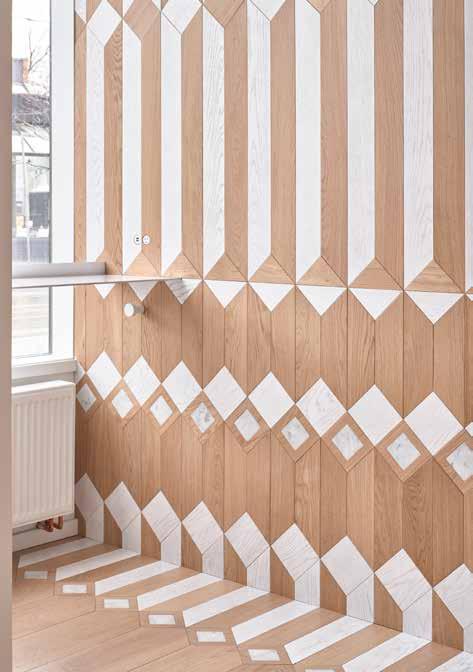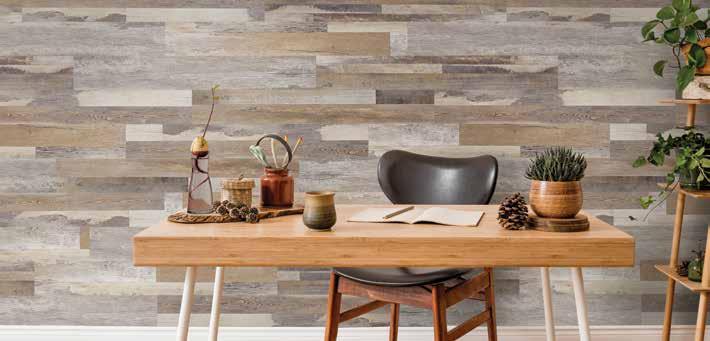
8 minute read
MOVING BEYOND WHAT’S UNDERFOOT
Flooring materials on walls make a statement with proper installation
By Clare Tattersall

Photos courtesy Doublespace Photography
There is no shortage of coffee shops in Canada, and for good reason. More than 70 per cent of adults fuel their day with at least one cup, according to the country’s coffee association. What’s not as prevalent are unique places to grab a brew, though specialty shops such as Milky’s are on the rise.
Opened in early 2019, at the bustling corner where Dundas and Bathurst Streets meet, the central Toronto cafe serves up high-quality coffee and other specialty drinks infused with ingredients like ginger and lemongrass that are as unconventional as the shop’s design. The tiny java house is almost entirely devoid of furniture for guests and features floorto-ceiling wood panelling to create a strong graphic pattern that ties Milky’s to its brand identity and founder Fraser Greenberg to his other line of work. Greenberg is also coowner of Relative Space, a hardwood flooring company located in the east end of the city and with a second office in New York. Not surprisingly, the engineered product used to wrap the 300-square-foot shop was supplied by the third-generation family business.
“It was a great opportunity to showcase what we can do with wood flooring,” says Greenberg, who lives near Milky’s and has called the neighbourhood home for years. “Covering the whole space is very impactful. The hard part was making it all work as a cohesive design.”
In collaboration with local architecture and design studio Batay-Csorba, Greenberg settled on a luxury modular flooring system called Matita. The collection, created by Fabio Rotella of Studio Rotella and Fabio Brotto of Foglie d’Oro, is comprised of three wood species (oak, European walnut and American black walnut), two marbles (Carrera marble and Marquina black marble) and three specialty outlines (burnished brass, wenge and maple), all placed on a diamond-shaped board that can be installed in a variety of patterns, from herringbone to chevron and

Photos courtesy Shaw Floors
beyond. Handmade in Italy, the wood has a lacquer finish and is available in five colours.
“Matita has different shapes and inserts that allow you to create repeating and nonrepeating patterns,” he says. “You can integrate different materials and colours, as well.”
Greenberg settled on oak in natural and white wood tones with interlocking Carrera marble segments. The more than 1,300 planks used transition seamlessly from floor to wall to ceiling and create a dynamic pattern that changes as it loops around the room.
The custom flooring was installed first with a glue-down method, while the wood on the walls and ceilings were glued and nailed into place. The entire installation took 10 days to complete.
Prep was essential to getting the install right as a lot of design was integrated with the wood pattern, says Greenberg. The ultra-white metal shelves that line the store’s perimeter and front counters protrude out from small cuts in the wood, and the electrical outlets are flush with the face of the boards.
“Making sure everything lined up was the hardest challenge,” he says. “It’s an old building, so there wasn’t a 90-degree angle to be found in the place.”
Lasers were used to ensure everything was level at 42 inches above the finished floor, which is the starting point of the pattern and the counter height. Minor adjustments had to be made row by row to guarantee perfection, making for a meticulous and slow installation.
“A lot of the design details in the space were placed according to the pattern, so even the
slightest offset would cause everything to be unaligned,” he explains. “It would go from satisfyingly geometric to frustratingly off.”
Further complicating matters was the inchand-a-half difference in height from one side of the floor to the other. The long boards had to be cut on-site to be slightly different heights to adjust for this irregularity.
The eye-catching finished product contributes to the “loud minimalist” aesthetic of the quaint shop, which serves as a shining example of how products specifically designed for the floor can be used in other applications.
“Wood flooring has a distinct look from most wood made for walls because of how it’s sawn,” says Greenberg. “Being able to use a material on more than one surface opens up a lot of design opportunities.”
Milky’s is just one example of flooring making its way up walls. The trend is being seen increasingly in both commercial and residential environments, and it’s not just limited to wood. Vinyl and laminate are also being used vertically, replacing wallpaper and paint to create that ‘wow’ factor and add dimension and texture to a space. These types of products closely mimic the visual of wood, stone and tile and are a more affordable option, generally costing two to three times less than the real thing. What’s more, they offer consumers the freedom to achieve the look of species that are not readily available in natural materials.
“In the past year, our home office has had to serve as the backdrop, offering a glimpse into our (lives) via virtual meetings,” says John Crews, director of hard surface design for Shaw Floors’ residential division. “A feature wall using flooring materials creates a distinctive style that can make a bold statement.”
Like other wall covering applications, Crews says it’s important to consider the space’s overall aesthetic before moving forward with the process. Existing colours, patterns and textures in a room will impact the design

\\ OPPOSITE PAGE: Installation using Shaw Floor’s Coretec in robin hickory. ABOVE: A feature wall in Coretec’s cabin oak adds a rustic look to this home office.
outcome; if they fight with what’s put on the wall instead of complementing it, then the desired effect will not be achieved.
An even greater consideration is whether the flooring material can be properly and safely installed. Crews says it’s prudent to consult the product’s user guidelines before doing so and to confirm whether vertical application negates any warranty.
The safest bet, says Crews, is to go with a product that has been categorically approved by the manufacturer for wall installation like Coretec. Many of the flooring line’s existing styles are suitable for just such application, so long as it’s done in a climate-controlled area and in accordance with local building codes, which may dictate weight restrictions for walls. The manufacturer’s technical guide suggests wet areas like bathrooms be avoided, as well as those around, for example, kitchen sinks. The luxury vinyl tile (LVT) can be installed without fasteners in residential settings. For commercial installations, the WPC (wood plastic composite) planks or SPC (stone plastic composite) tiles must be fastened to studs or plywood.
Taking a flooring installation up the wall will vary depending on the chosen material, product manufacturer/brand and vertical space, among other factors. Mapei Canada regional technical representative Shawn Millman says materials with a smooth backing — whether laminate, wood, vinyl or composite — will result in more surface area contact with the installation media, which is usually adhesive or double-sided tape.
“The type used must be compatible with the surfaces it is bonding together, both substrate and flooring materials,” says Millman.
For wood or vinyl flooring, either bonding agent can be employed, with the benefits and challenges of each weighed out by the installer beforehand, says Millman.
A cartridge-based urethane adhesive, such as Ultrabond ECO 907, is best-suited for wood products. Installers simply squeeze the adhesive from the cartridge onto the wall as rows of planks are added. This adhesive is applied while wet and has a limited open time, so it’s important that installers don’t get too far ahead of themselves. Ultrabond ECO 373 is ideal for vinyl products and can also be used to install cork sheet. Millman advises utilizing a small notched spreader or medium nap roller to put a uniformly-applied pattern or film thickness of glue on the wall. Once complete, allow the glue to fully dry to the touch before installing the product onto the adhesive.
“Regardless of the adhesive chosen, take care to use drop sheets and be very mindful that adhesive drops and runs. Squeeze-out also needs to be considered,” says Millman. “Be ready to clean up those small inconveniences as they occur while the adhesive is still wet.”
Double-sided tape provides instant bond and immediate utilization without the waiting and open-time restrictions associated with adhesive, he continues. Working with it is also not as messy. However, it’s imperative that the wall is plumb and level, and the flooring product has a flat back to ensure the tape attains 100 per cent contact with the wall. Mapecontact MRT and Mapecontact SRT can both be used for the installation of hardwood, LVT, laminate, cork and other flooring materials.
“Mapecontact MRT is a very thin product, which should be used if indentation of the wall covering is a concern, such as with some vinyl products,” says Millman. “Mapecontact SRT has an integral foam core that can help diminish slight texture and surface irregularities. This makes it slightly more forgiving to the installer, with regard to future movement stress, drywall screw head pops and other issues of that sort.”
Beyond bonding considerations, installers should ensure the wall surface is sound, stable, flat and free of contaminants prior to product application. Materials selected should also be of a reasonably low weight, says Millman. When installing a heavier covering like engineered hardwood, fasteners are encouraged, if there is an opportunity to use them. This can help during the installation process and with the longevity of the overall work.
“Anyone can achieve great things with the proper products and installation materials, though installer know-how and experience are an asset when it comes to skill in application,” says Millman. “Preparation is also key, so I recommend doing some research and checking the manual of the flooring to be used, if you feel at all uncomfortable. The end result will not only be a job well-done but a unique wall design that can have a dramatic impact on the attractiveness of a space.”



